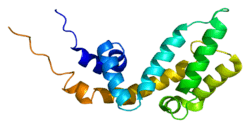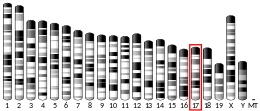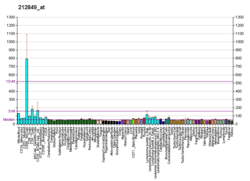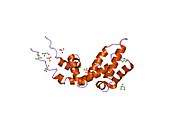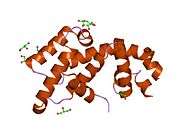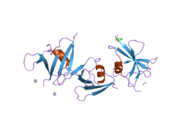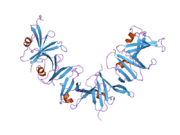AXIN1
Axin-1 is a protein that in humans is encoded by the AXIN1 gene.[5]
Function
This gene encodes a cytoplasmic protein which contains a regulation of G-protein signaling (RGS) domain and a dishevelled and axin (DIX) domain. The encoded protein interacts with adenomatosis polyposis coli, catenin (cadherin-associated protein) beta 1, glycogen synthase kinase 3 beta, protein phosphatase 2, and itself. This protein functions as a negative regulator of the wingless-type MMTV integration site family, member 1 (WNT) signaling pathway and can induce apoptosis. The crystal structure of a portion of this protein, alone and in a complex with other proteins, has been resolved. Mutations in this gene have been associated with hepatocellular carcinoma, hepatoblastomas, ovarian endometrioid adenocarcinomas, and medulloblastomas. Two transcript variants encoding distinct isoforms have been identified for this gene.[6]
Structure
The full-length human protein comprises 862 amino acids with a (predicted) molecular mass of 96 kDa. The N-terminal RGS domain, a GSK3 kinase interacting peptide of Axin1 and homologs of the C-terminal DIX domains have been solved at atomic resolution. Large WNT-downregulating central regions have been characterized as intrinsically disordered by biophysical experiments and bioinformatic analysis.[7] Biophysical destabilization of the folded RGS domain induces formation of nanoaggregates that expose and locally concentrate intrinsically disordered regions, which in turn misregulate Wnt signalling. Many other large IDPs (Intrinsically Disordered Proteins) are affected by missense mutations, such as BRCA1, Adenomatous polyposis coli, CREB-binding protein/(CBP) and might be affected in similar ways by missense mutations of their folded domains.[8]
Interactions
AXIN1 has been shown to interact with:
References
- GRCh38: Ensembl release 89: ENSG00000103126 - Ensembl, May 2017
- GRCm38: Ensembl release 89: ENSMUSG00000024182 - Ensembl, May 2017
- "Human PubMed Reference:". National Center for Biotechnology Information, U.S. National Library of Medicine.
- "Mouse PubMed Reference:". National Center for Biotechnology Information, U.S. National Library of Medicine.
- Zeng L, Fagotto F, Zhang T, Hsu W, Vasicek TJ, Perry WL, Lee JJ, Tilghman SM, Gumbiner BM, Costantini F (August 1997). "The mouse Fused locus encodes Axin, an inhibitor of the Wnt signaling pathway that regulates embryonic axis formation". Cell. 90 (1): 181–92. doi:10.1016/S0092-8674(00)80324-4. PMID 9230313.
- "Entrez Gene: AXIN1 axin 1".
- Noutsou M, Duarte AM, Anvarian Z, Didenko T, Minde DP, Kuper I, de Ridder I, Oikonomou C, Friedler A, Boelens R, Rüdiger SG, Maurice MM (2011). "Critical scaffolding regions of the tumor suppressor Axin1 are natively unfolded". J Mol Biol. 405 (3): 773–86. doi:10.1016/j.jmb.2010.11.013. PMID 21087614.
- Anvarian Z, Nojima H, van Kappel EC, Madl T, Spit M, Viertler M, Jordens I, Low TY, van Scherpenzeel RC, Kuper I, Richter K, Heck AJ, Boelens R, Vincent JP, Rüdiger SG, Maurice MM (2016). "Axin cancer mutants form nanoaggregates to rewire the Wnt signaling network". Nat Struct Mol Biol. 23 (4): 324–32. doi:10.1038/nsmb.3191. PMID 26974125.
- Nakamura T, Hamada F, Ishidate T, Anai K, Kawahara K, Toyoshima K, Akiyama T (June 1998). "Axin, an inhibitor of the Wnt signalling pathway, interacts with beta-catenin, GSK-3beta and APC and reduces the beta-catenin level". Genes Cells. 3 (6): 395–403. doi:10.1046/j.1365-2443.1998.00198.x. PMID 9734785.
- Hocevar BA, Mou F, Rennolds JL, Morris SM, Cooper JA, Howe PH (June 2003). "Regulation of the Wnt signaling pathway by disabled-2 (Dab2)". EMBO J. 22 (12): 3084–94. doi:10.1093/emboj/cdg286. PMC 162138. PMID 12805222.
- Zhang Y, Qiu WJ, Chan SC, Han J, He X, Lin SC (May 2002). "Casein kinase I and casein kinase II differentially regulate axin function in Wnt and JNK pathways". J. Biol. Chem. 277 (20): 17706–12. doi:10.1074/jbc.M111982200. PMID 11884395.
- Kim MJ, Chia IV, Costantini F (November 2008). "SUMOylation target sites at the C terminus protect Axin from ubiquitination and confer protein stability". FASEB J. 22 (11): 3785–94. doi:10.1096/fj.08-113910. PMC 2574027. PMID 18632848.
- Li L, Yuan H, Weaver CD, Mao J, Farr GH, Sussman DJ, Jonkers J, Kimelman D, Wu D (August 1999). "Axin and Frat1 interact with dvl and GSK, bridging Dvl to GSK in Wnt-mediated regulation of LEF-1". EMBO J. 18 (15): 4233–40. doi:10.1093/emboj/18.15.4233. PMC 1171499. PMID 10428961.
- Mak BC, Takemaru K, Kenerson HL, Moon RT, Yeung RS (February 2003). "The tuberin-hamartin complex negatively regulates beta-catenin signaling activity". J. Biol. Chem. 278 (8): 5947–51. doi:10.1074/jbc.C200473200. PMID 12511557.
- Mao J, Wang J, Liu B, Pan W, Farr GH, Flynn C, Yuan H, Takada S, Kimelman D, Li L, Wu D (April 2001). "Low-density lipoprotein receptor-related protein-5 binds to Axin and regulates the canonical Wnt signaling pathway". Mol. Cell. 7 (4): 801–9. doi:10.1016/S1097-2765(01)00224-6. PMID 11336703.
- Zhang Y, Neo SY, Han J, Lin SC (August 2000). "Dimerization choices control the ability of axin and dishevelled to activate c-Jun N-terminal kinase/stress-activated protein kinase". J. Biol. Chem. 275 (32): 25008–14. doi:10.1074/jbc.M002491200. PMID 10829020.
- Yamamoto H, Hinoi T, Michiue T, Fukui A, Usui H, Janssens V, Van Hoof C, Goris J, Asashima M, Kikuchi A (July 2001). "Inhibition of the Wnt signaling pathway by the PR61 subunit of protein phosphatase 2A". J. Biol. Chem. 276 (29): 26875–82. doi:10.1074/jbc.M100443200. PMID 11297546.
Further reading
- Segditsas S, Tomlinson I (2007). "Colorectal cancer and genetic alterations in the Wnt pathway". Oncogene. 25 (57): 7531–7. doi:10.1038/sj.onc.1210059. PMID 17143297.
- Flint J, Thomas K, Micklem G, Raynham H, Clark K, Doggett NA, King A, Higgs DR (1997). "The relationship between chromosome structure and function at a human telomeric region". Nat. Genet. 15 (3): 252–7. doi:10.1038/ng0397-252. PMID 9054936.
- Ikeda S, Kishida S, Yamamoto H, Murai H, Koyama S, Kikuchi A (1998). "Axin, a negative regulator of the Wnt signaling pathway, forms a complex with GSK-3beta and beta-catenin and promotes GSK-3beta-dependent phosphorylation of beta-catenin". EMBO J. 17 (5): 1371–84. doi:10.1093/emboj/17.5.1371. PMC 1170485. PMID 9482734.
- Hart MJ, de los Santos R, Albert IN, Rubinfeld B, Polakis P (1998). "Downregulation of beta-catenin by human Axin and its association with the APC tumor suppressor, beta-catenin and GSK3 beta". Curr. Biol. 8 (10): 573–81. doi:10.1016/S0960-9822(98)70226-X. PMID 9601641.
- Nakamura T, Hamada F, Ishidate T, Anai K, Kawahara K, Toyoshima K, Akiyama T (1998). "Axin, an inhibitor of the Wnt signalling pathway, interacts with beta-catenin, GSK-3beta and APC and reduces the beta-catenin level". Genes Cells. 3 (6): 395–403. doi:10.1046/j.1365-2443.1998.00198.x. PMID 9734785.
- Hsu W, Zeng L, Costantini F (1999). "Identification of a domain of Axin that binds to the serine/threonine protein phosphatase 2A and a self-binding domain". J. Biol. Chem. 274 (6): 3439–45. doi:10.1074/jbc.274.6.3439. PMID 9920888.
- Kitagawa M, Hatakeyama S, Shirane M, Matsumoto M, Ishida N, Hattori K, Nakamichi I, Kikuchi A, Nakayama K, Nakayama K (1999). "An F-box protein, FWD1, mediates ubiquitin-dependent proteolysis of beta-catenin". EMBO J. 18 (9): 2401–10. doi:10.1093/emboj/18.9.2401. PMC 1171323. PMID 10228155.
- Fagotto F, Jho Eh, Zeng L, Kurth T, Joos T, Kaufmann C, Costantini F (1999). "Domains of axin involved in protein-protein interactions, Wnt pathway inhibition, and intracellular localization". J. Cell Biol. 145 (4): 741–56. doi:10.1083/jcb.145.4.741. PMC 2133179. PMID 10330403.
- Kodama S, Ikeda S, Asahara T, Kishida M, Kikuchi A (1999). "Axin directly interacts with plakoglobin and regulates its stability". J. Biol. Chem. 274 (39): 27682–8. doi:10.1074/jbc.274.39.27682. PMID 10488109.
- Jho Eh, Lomvardas S, Costantini F (2000). "A GSK3beta phosphorylation site in axin modulates interaction with beta-catenin and Tcf-mediated gene expression". Biochem. Biophys. Res. Commun. 266 (1): 28–35. doi:10.1006/bbrc.1999.1760. PMID 10581160.
- Ikeda S, Kishida M, Matsuura Y, Usui H, Kikuchi A (2000). "GSK-3beta-dependent phosphorylation of adenomatous polyposis coli gene product can be modulated by beta-catenin and protein phosphatase 2A complexed with Axin". Oncogene. 19 (4): 537–45. doi:10.1038/sj.onc.1203359. PMID 10698523.
- Satoh S, Daigo Y, Furukawa Y, Kato T, Miwa N, Nishiwaki T, Kawasoe T, Ishiguro H, Fujita M, Tokino T, Sasaki Y, Imaoka S, Murata M, Shimano T, Yamaoka Y, Nakamura Y (2000). "AXIN1 mutations in hepatocellular carcinomas, and growth suppression in cancer cells by virus-mediated transfer of AXIN1". Nat. Genet. 24 (3): 245–50. doi:10.1038/73448. PMID 10700176.
- Spink KE, Polakis P, Weis WI (2000). "Structural basis of the Axin-adenomatous polyposis coli interaction". EMBO J. 19 (10): 2270–9. doi:10.1093/emboj/19.10.2270. PMC 384355. PMID 10811618.
- Zhang Y, Neo SY, Han J, Lin SC (2000). "Dimerization choices control the ability of axin and dishevelled to activate c-Jun N-terminal kinase/stress-activated protein kinase". J. Biol. Chem. 275 (32): 25008–14. doi:10.1074/jbc.M002491200. PMID 10829020.
- Daniels RJ, Peden JF, Lloyd C, Horsley SW, Clark K, Tufarelli C, Kearney L, Buckle VJ, Doggett NA, Flint J, Higgs DR (2001). "Sequence, structure and pathology of the fully annotated terminal 2 Mb of the short arm of human chromosome 16". Hum. Mol. Genet. 10 (4): 339–52. doi:10.1093/hmg/10.4.339. PMID 11157797.
- Yamamoto H, Hinoi T, Michiue T, Fukui A, Usui H, Janssens V, Van Hoof C, Goris J, Asashima M, Kikuchi A (2001). "Inhibition of the Wnt signaling pathway by the PR61 subunit of protein phosphatase 2A". J. Biol. Chem. 276 (29): 26875–82. doi:10.1074/jbc.M100443200. PMID 11297546.
- Mao J, Wang J, Liu B, Pan W, Farr GH, Flynn C, Yuan H, Takada S, Kimelman D, Li L, Wu D (2001). "Low-density lipoprotein receptor-related protein-5 binds to Axin and regulates the canonical Wnt signaling pathway". Mol. Cell. 7 (4): 801–9. doi:10.1016/S1097-2765(01)00224-6. PMID 11336703.
- Furuhashi M, Yagi K, Yamamoto H, Furukawa Y, Shimada S, Nakamura Y, Kikuchi A, Miyazono K, Kato M (2001). "Axin facilitates Smad3 activation in the transforming growth factor beta signaling pathway". Mol. Cell. Biol. 21 (15): 5132–41. doi:10.1128/MCB.21.15.5132-5141.2001. PMC 87238. PMID 11438668.
- Rubinfeld B, Tice DA, Polakis P (2001). "Axin-dependent phosphorylation of the adenomatous polyposis coli protein mediated by casein kinase 1epsilon". J. Biol. Chem. 276 (42): 39037–45. doi:10.1074/jbc.M105148200. PMID 11487578.
